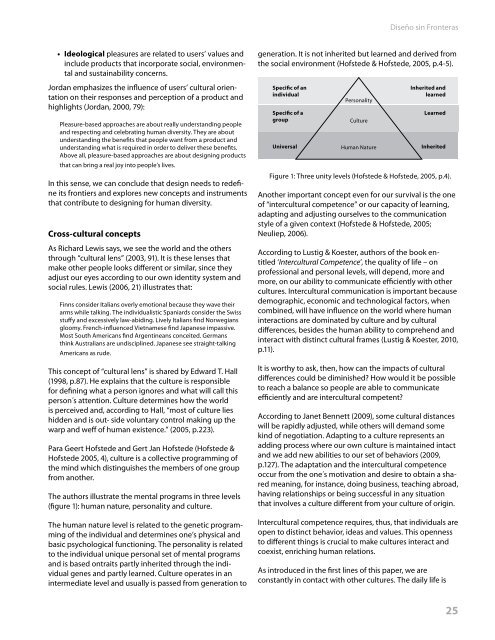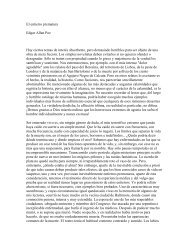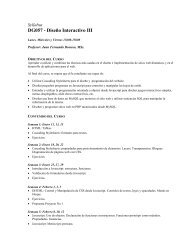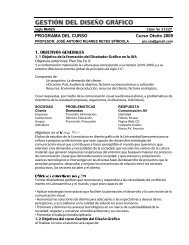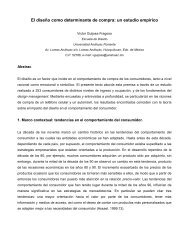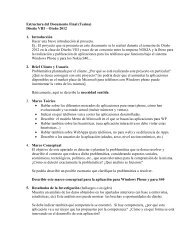Diseño sin Fronteras I<strong>de</strong>ological pleasures are related to users’ values andinclu<strong>de</strong> products that incorporate social, environmentaland sustainability concerns.Jordan emphasizes the influence of users’ cultural orientationon their responses and perception of a product andhighlights (Jordan, 2000, 79):Pleasure-based approaches are about really un<strong>de</strong>rstanding peopleand respecting and celebrating human diversity. They are aboutun<strong>de</strong>rstanding the benefits that people want from a product andun<strong>de</strong>rstanding what is required in or<strong>de</strong>r to <strong>de</strong>liver these benefits.Above all, pleasure-based approaches are about <strong>de</strong>signing productsthat can bring a real joy into people’s lives.In this sense, we can conclu<strong>de</strong> that <strong>de</strong>sign needs to re<strong>de</strong>fineits frontiers and explores new concepts and instrumentsthat contribute to <strong>de</strong>signing for human diversity.Cross-cultural conceptsAs Richard Lewis says, we see the world and the othersthrough “cultural lens” (2003, 91). It is these lenses thatmake other people looks different or similar, since theyadjust our eyes according to our own i<strong>de</strong>ntity system andsocial rules. Lewis (2006, 21) illustrates that:Finns consi<strong>de</strong>r Italians overly emotional because they wave theirarms while talking. The individualistic Spaniards consi<strong>de</strong>r the Swissstuffy and excessively law-abiding. Lively Italians find Norwegiansgloomy. French-influenced Vietnamese find Japanese impassive.Most South Americans find Argentineans conceited. Germansthink Australians are undisciplined. Japanese see straight-talkingAmericans as ru<strong>de</strong>.This concept of “cultural lens” is shared by Edward T. Hall(1998, p.87). He explains that the culture is responsiblefor <strong>de</strong>fining what a person ignores and what will call thisperson´s attention. Culture <strong>de</strong>termines how the worldis perceived and, according to Hall, “most of culture lieshid<strong>de</strong>n and is out- si<strong>de</strong> voluntary control making up thewarp and weff of human existence.” (2005, p.223).Para Geert Hofste<strong>de</strong> and Gert Jan Hofste<strong>de</strong> (Hofste<strong>de</strong> &Hofste<strong>de</strong> 2005, 4), culture is a collective programming ofthe mind which distinguishes the members of one groupfrom another.The authors illustrate the mental programs in three levels(figure 1): human nature, personality and culture.The human nature level is related to the genetic programmingof the individual and <strong>de</strong>termines one’s physical andbasic psychological functioning. The personality is relatedto the individual unique personal set of mental programsand is based ontraits partly inherited through the individualgenes and partly learned. Culture operates in anintermediate level and usually is passed from generation togeneration. It is not inherited but learned and <strong>de</strong>rived fromthe social environment (Hofste<strong>de</strong> & Hofste<strong>de</strong>, 2005, p.4-5).Specific of anindividualSpecific of agroupUniversalPersonalityCultureHuman NatureInherited andlearnedLearnedInheritedFigure 1: Three unity levels (Hofste<strong>de</strong> & Hofste<strong>de</strong>, 2005, p.4).Another important concept even for our survival is the oneof “intercultural competence” or our capacity of learning,adapting and adjusting ourselves to the communicationstyle of a given context (Hofste<strong>de</strong> & Hofste<strong>de</strong>, 2005;Neuliep, 2006).According to Lustig & Koester, authors of the book entitled‘Intercultural Competence’, the quality of life – onprofessional and personal levels, will <strong>de</strong>pend, more andmore, on our ability to communicate efficiently with othercultures. Intercultural communication is important because<strong>de</strong>mographic, economic and technological factors, whencombined, will have influence on the world where humaninteractions are dominated by culture and by culturaldifferences, besi<strong>de</strong>s the human ability to comprehend andinteract with distinct cultural frames (Lustig & Koester, 2010,p.11).It is worthy to ask, then, how can the impacts of culturaldifferences could be diminished? How would it be possibleto reach a balance so people are able to communicateefficiently and are intercultural competent?According to Janet Bennett (2009), some cultural distanceswill be rapidly adjusted, while others will <strong>de</strong>mand somekind of negotiation. Adapting to a culture represents anadding process where our own culture is maintained intactand we add new abilities to our set of behaviors (2009,p.127). The adaptation and the intercultural competenceoccur from the one´s motivation and <strong>de</strong>sire to obtain a sharedmeaning, for instance, doing business, teaching abroad,having relationships or being successful in any situationthat involves a culture different from your culture of origin.Intercultural competence requires, thus, that individuals areopen to distinct behavior, i<strong>de</strong>as and values. This opennessto different things is crucial to make cultures interact andcoexist, enriching human relations.As introduced in the first lines of this paper, we areconstantly in contact with other cultures. The daily life is25
MX Design Conference 2011intercultural. In this sense, it becomes easy to agree withGeert Hofste<strong>de</strong>, Gert Jan Hofste<strong>de</strong>, Michael Minkov whenthey say that people need, urgently, be capable of collaboratewithin different moral circles and to tolerate symbolicdifferences (Hofste<strong>de</strong> et. al 2010, p.473). The authors saythat differences among people will always exist, but it isnecessary to learn to coexist without wanting that we areall the same (2010, p.447).Thus, we may consi<strong>de</strong>r the concept of intercultural competenceas one of the challenges of the <strong>de</strong>signer of 2015.Mo<strong>de</strong>ls of cultural categorizationAccording to Richard Lewis (2006, p.39), the categorizationof a culture is necessary and obvious because it allows us,among other actions, to foresee the behavior of individualsfrom an specific culture; to clarify why people act certainway; to avoid offenses; to find a unity and to standardizepolicies.Given the relevance of the actions mentioned abovetowards the <strong>de</strong>velopment of products and services, twomo<strong>de</strong>ls of cultural categorization will be introduced:the first, articulated by Richard Lewis, one of the mostimportant linguistics from the United Kingdom, with largeaca<strong>de</strong>mic and professional experience on cross-culturalstudies in various countries. The second mo<strong>de</strong>l belongs toGeert Hofste<strong>de</strong>, Dutch, PhD in Social Psychology, professoremeritus of Organizational Anthropology and InternationalManagement at Maastricht University, The Netherlands.He is the co-foun<strong>de</strong>r and first director of the Institute forResearch on Intercultural Cooperation (IRIC).People from linear-active cultures, on the other hand,value facts, planning, products, chronograms, co-relationof actions and words, institutions and laws. Such valuescan be observed through their planned and or<strong>de</strong>red livesand, besi<strong>de</strong>s that, through their professional orientation, inother associations and institutions. Lewis complements the<strong>de</strong>scription clarifying that:Linear-active people like Swe<strong>de</strong>s, Swiss, Dutch and Germans, do onething at a time, concentrate hard on that thing and do it within ascheduled time period. These people think that in this way they aremore efficient and get more done. (p. 30)Eventually, individuals from reactive cultures value theinstitution, courtesy, networking, common obligations,collective harmony and face protection. Such characteristicsare reflected in the very polite social and professionalbehavior, in the act of avoiding confrontation and in thevalorization of harmonic relations. The author says:Japan belongs to the group of reactive, or listening, cultures, themembers of which rarely initiate action or discussion, preferring tolisten to and establish the other’s position first, then react to it andformulate their own (p. 32).The following diagram (figure 2) indicates the relativeposition of each culture according to Lewis mo<strong>de</strong>l: multiactive,linear-active and reactive.The Lewis Mo<strong>de</strong>lRichard Lewis´ culture categorization mo<strong>de</strong>l (2006) wasestablished through the observation, research and evaluationof cultural profiles from 68 different nationalities. Themo<strong>de</strong>l classifies cultures into three categories: multi-active,linear-active and reactive.Individuals from multi-active cultures value family, hierarchy,relations, emotion, eloquence, persuasion and loyalty.These values, according to Lewis, are reflected in the socialand professional behavior of the whole group. Some ofthe characteristics of individuals from multi-active culturesare: talkative, loquacious and warm. While explaining thenature of multi-active cultures, Lewis says that:Multi-active people are not very interested in schedules or punctuality.They pretend to observe them, especially if a linear-active partnerinsists. They consi<strong>de</strong>r reality to be more important than man-ma<strong>de</strong>appointments. (p. 30)Figure 2: Types of culture: the Lewis Mo<strong>de</strong>l. (http://www.crossculture.com/UserFiles/Image/The_Lewis_Mo<strong>de</strong>l_712.jpg)Hofste<strong>de</strong> cultural dimensionsOne of the most relevant contributions to cultural studiesconcerns the cultural dimensions of Geert Hofste<strong>de</strong>. Thecultural dimensions were <strong>de</strong>termined through a research<strong>de</strong>veloped at IBM, between 1967 and 1973, with 100thousand employees from 50 different countries. The26
- Page 2 and 3: MX Design Conference 2011Diseño si
- Page 4 and 5: ÍndiceCapeltic, una experiencia in
- Page 6 and 7: Diseño sin FronterasCapeltic, una
- Page 8 and 9: Diseño sin FronterasInvestigacione
- Page 10 and 11: Diseño sin Fronteras2) Una Empresa
- Page 12 and 13: Diseño sin Fronteras Se trabaja co
- Page 14 and 15: Diseño sin FronterasAhora bien, al
- Page 16 and 17: Diseño sin Fronteraslas personas a
- Page 18 and 19: Diseño sin FronterasDe esta manera
- Page 20 and 21: Diseño sin FronterasTercera fase:
- Page 22 and 23: Diseño sin FronterasDesign & Cultu
- Page 26 and 27: Diseño sin Fronterasmain objective
- Page 28 and 29: Diseño sin FronterasHofstede´s cu
- Page 30 and 31: Diseño sin FronterasJORDAN, P., De
- Page 32 and 33: Diseño sin Fronterasour personalit
- Page 34 and 35: Diseño sin FronterasThe Color in D
- Page 36 and 37: Diseño sin FronterasDesign in Teac
- Page 38 and 39: Diseño sin FronterasWe introduce t
- Page 40 and 41: Diseño sin Fronterasintellectual b
- Page 42 and 43: Diseño sin FronterasDesign Laborat
- Page 44 and 45: Diseño sin Fronterassustainable de
- Page 46 and 47: Diseño sin Fronteras4) Web design
- Page 48 and 49: Diseño sin Fronterasdemonstrating
- Page 50 and 51: Diseño sin Fronteraswith an encomp
- Page 52 and 53: Diseño sin FronterasDesign, Cultur
- Page 54 and 55: Diseño sin Fronterasb. Clothing: c
- Page 56 and 57: Diseño sin Fronterasappropriate fo
- Page 58 and 59: Diseño sin FronterasReferencesAPPA
- Page 60 and 61: Diseño sin Fronterasconocimiento 3
- Page 62 and 63: Diseño sin FronterasEntre los resu
- Page 64 and 65: Diseño sin FronterasOncología. Di
- Page 66 and 67: Diseño sin FronterasDistributed Co
- Page 68 and 69: Diseño sin Fronteras3 COLS: Web-ba
- Page 70 and 71: Diseño sin Fronterasoutcome, ‘pr
- Page 72 and 73: Diseño sin FronterasTable 1. List
- Page 74 and 75:
Diseño sin Fronterasin which they
- Page 76 and 77:
Diseño sin FronterasWithout attent
- Page 78 and 79:
Diseño sin Fronterasexample, the d
- Page 80 and 81:
Diseño sin Fronteras(fig.1). Despu
- Page 82 and 83:
Diseño sin FronterasEl diseño est
- Page 84 and 85:
Diseño sin Fronteras1. Ser un medi
- Page 86 and 87:
Diseño sin FronterasEl diseño est
- Page 88 and 89:
Diseño sin Fronterascionados con l
- Page 90 and 91:
Diseño sin FronterasR&.)''$--)'"&+
- Page 92 and 93:
Diseño sin FronterasSegún la inve
- Page 94 and 95:
Diseño sin Fronterasde educación
- Page 96 and 97:
Diseño sin FronterasEnfoque y meto
- Page 98 and 99:
Diseño sin FronterasLos esquemas p
- Page 100 and 101:
Diseño sin FronterasWireframes - S
- Page 102 and 103:
Diseño sin FronterasEstos efectos
- Page 104 and 105:
Diseño sin Fronterasa special ques
- Page 106 and 107:
Diseño sin Fronteras“cool” tre
- Page 108 and 109:
Diseño sin Fronterasy por esta raz
- Page 110 and 111:
Diseño sin Fronterasindustrial. Va
- Page 112 and 113:
Diseño sin Fronterasmejor desempe
- Page 114 and 115:
Diseño sin Fronterasganancia econ
- Page 116 and 117:
Diseño sin Fronterasproposing solu
- Page 118 and 119:
Diseño sin Fronteras3. The first r
- Page 120 and 121:
Diseño sin FronterasInterdisciplin
- Page 122 and 123:
Diseño sin Fronterasu opor tunidad
- Page 124 and 125:
Diseño sin Fronterasla formulació
- Page 126 and 127:
Diseño sin FronterasInterdisciplin
- Page 128 and 129:
Diseño sin Fronterasreal de una or
- Page 130 and 131:
Diseño sin FronterasConclusionesHa
- Page 132 and 133:
Diseño sin FronterasEn numerosas o
- Page 134 and 135:
Diseño sin Fronterashace reflexion
- Page 136 and 137:
Diseño sin Fronterasocasiones no e
- Page 138 and 139:
Diseño sin Fronterascondición de
- Page 140 and 141:
Diseño sin FronterasLa psicología
- Page 142 and 143:
Diseño sin FronterasReferencias bi
- Page 144 and 145:
Diseño sin FronterasMetodologíaLa
- Page 146 and 147:
Diseño sin Fronterasvisión se com
- Page 148 and 149:
Diseño sin FronterasLa mediación
- Page 150 and 151:
Diseño sin Fronteraspermiten el ac
- Page 152 and 153:
Diseño sin Fronterassolo el 5% de
- Page 154 and 155:
Diseño sin FronterasFrías, J. (20
- Page 156 and 157:
Diseño sin FronterasLa noción de
- Page 158 and 159:
Diseño sin FronterasMirada de Muje
- Page 160 and 161:
Diseño sin Fronterasidentidades, d
- Page 162 and 163:
Diseño sin FronterasIntroducciónE
- Page 164 and 165:
Diseño sin Fronteraso revelan a tr
- Page 166 and 167:
Diseño sin FronterasCon respecto t
- Page 168 and 169:
Diseño sin Fronterasprofesional y
- Page 170 and 171:
Diseño sin Fronteras¿Qué es wiri
- Page 172 and 173:
Diseño sin FronterasWiring es una
- Page 174 and 175:
Diseño sin FronterasSources of inn
- Page 176 and 177:
Diseño sin FronterasFeatureDescrip
- Page 178 and 179:
Diseño sin FronterasEncoding relev
- Page 180 and 181:
Diseño sin FronterasThe new design
- Page 182 and 183:
Diseño sin Fronteraslearn by doing
- Page 184 and 185:
Diseño sin FronterasThe Open(d) Fr
- Page 186 and 187:
Diseño sin Fronterasdisseminate th
- Page 188 and 189:
Diseño sin Fronterascontrib- ute d
- Page 190 and 191:
Diseño sin FronterasThe same digit
- Page 192 and 193:
Diseño sin Fronterasque desde todo
- Page 194 and 195:
Diseño sin FronterasFigura 4 refer


